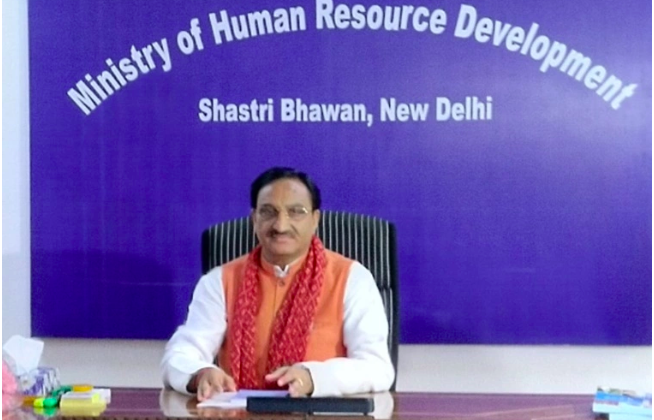A War For Scientists to Join

Surely India’s scientific community must be waking up to the realisation that their silence is detrimental to scientific development and allows many varieties of mischief to breed. In a rare show of gumption, students of the elite engineering institute, IIT Bombay, have slammed the recent decision to invite the Human Resources Development (HRD) Minister Ramesh Pokhriyal ‘Nishank’ to chair their graduation ceremony.
For too long India’s scientists have remained silent—even the credulous claims by Prime Minister Narendra Modi in a speech at the Ambani hospital in November 2014 was not challenged by them for a long time. A key role has to be played by the scientific community in the ongoing battle of ideas. Perhaps students of IIT Bombay show the way.
They have said in their in-house publication, Insight IIT Bombay, that a guest who “recognised, embodied and endorsed the scientific and moral values” of their institute should have been invited instead of the minister. Their problem is with Pokhriyal's speech, pervaded by unscientific claims and “twisted facts”. They are under no illusion the speech tried to stoke “patriotic feelings”. To the IIT students, the speech was a “mild form of scientific blasphemy”.
Their logic is sound: Ramesh Pokhriyal is a repeat offender who had claimed in Parliament that astrology is “the biggest science”. At the convocation at IIT Kharagpur, the minister had said that “...if a computer ever spoke it would speak in Sanskrit.” At IIT Bombay, the minister claimed that Ram Setu—Adam’s Bridge, the chain of limestone shoals that connects Rameswaram Island in Tamil Nadu with the Mannar Island in Sri Lanka—was built by “our engineers in ancient times”. There is, of course, no conclusive proof of this. From here, the minister swerved north, claiming that the Himalayan mountain ranges consume “all the poisonous things which we are releasing and saving the world”.
This curious mix of mythology and science is not the usual fare an elected representative is expected to dish out. The oath Pokhriyal took on the Constitution requires him to swear by its prescriptions for developing a scientific temper and the spirit of inquiry. His liberty to his own views aside, on public forums he must not contradict what the Constitution enjoins on all citizens.
Yet, instances about of people in official positions and elected representatives (usually those aligned to the party controlling the Centre) feel they can make unscientific and irrational statements based on dubious claims about ancient India. Justice V Chitambaresh, a sitting judge of Kerala High Court, was widely criticised for saying at a recent Tamil Brahmin Global Meet, a public function, that brahmins should be at the helm of the country’s affairs. Pokhriyal is certainly not above criticism from the scientists—and science students—before whom he is sermonising pseudo-science.
This is a war on science led by the BJP and its acolytes and the scientific community must not ignore it. For the Hindtuvadis, religion is not a matter of personal belief but a key feature of identity politics and it is deployed to maintain a social order infused with discipline and conformity.
That is why the legislator from Assam said that playing the flute before a cow can increase milk production and the Member of Parliament from Bhopal, Pragya Singh Thakur, made the incredible claim that marak shakti—slaying power—is being used against leaders of the Bharatiya Janata Party (BJP) by its rivals. Former Union Science and Technology Minister Harsh Vardhan claims before a gathering of scientists falls in the same category: He had said that the cosmologist Stephen Hawking considered Vedic theories are superior to Albert Einstein's famous theory of mass-energy equivalence. Of course, this is not true.
In fact, it is the Prime Minister who inaugurated this trend which aims to legitimise the Hindu-nationalist belief that “many discoveries of modern science and technology were known to the people of ancient India,” as he told Mumbai doctors in 2014. The mythological figure Karna and the Hindu god, Ganesha, Modi had said, were creations of cosmetic surgery and reproductive genetics “used thousands of years ago”.
Of late, a section of scientists have migrated to the saffron cause; why else would prominent space scientist and former ISRO chairman G Madhavan Nair claim that there could be water on the moon as it is claimed in some shlokas [the most popular form of verse line used in Sanskrit poetry, its metre said to be derived from Vedic literature].
Still, students of IIT Kharagpur had issued a statement against the police action on Anand Teltumbde, a civil rights activist, and several teachers and alumni of the institute. Perhaps they will not silently accept the sermonising they receive from leaders peddling psuedo-science in many different ways.
At the end of the first term of the BJP-led National Democratic Alliance government, more than 200 scientists appealed to Indian voters to reject intolerance, lynching, assaults, discrimination on religious grounds, or on the basis of caste, gender, language or region. When it was issued, the letter was considered and unusual move from India’s research community, who rarely male political or social interventions.
It is incumbent on the Speaker of Parliament and the President of India to promote the scientific temper and a spirit of enquiry and reform. It is not too much to expect them—even unsuccessfully—to counter the blather with a dash of sense.
Last month, India launched Chandrayaan 2, a mission to land a rover on the moon. This was considered as a significant step demonstrating scientific and engineering capacity. “It put India firmly within a select group of countries prowling the solar system for commercial, strategic, and scientific reasons,” as Pervez Hoodbhoy, the prominent Pakistani physicist and human rights activist, wrote in Dawn newspaper.
“It is natural that India’s Hindutva government should boast Chandrayaan-2 as its own achievement and claim continuation with imagined glories from Vedic times. But rightfully the credit goes elsewhere. Just imagine if history could be wound back by 70-80 years and prime minister Jawaharlal Nehru was replaced by Narendra Modi... an army of rishis [sages] would outnumber physicists. The cure for cancer would be sought in yoga while floods and earthquakes would somehow be linked to cow slaughter. Instead of devising Chandrayaan, Indian scientists would be searching for the fictitious Vimana of Ravana.
But Nehru or not, the war on science is on and cannot be fought by scientist unless India’s actual achievements in the field are re-emphasised. Ordinary students, teachers and intellectuals must question patently false claims, scrutinise them and ridicule such pearls of wisdom. This is why the students of IIT Bombay are worth emulating.
Subhash Gatade is an activist and social and political commentator. Views are personal.
Get the latest reports & analysis with people's perspective on Protests, movements & deep analytical videos, discussions of the current affairs in your Telegram app. Subscribe to NewsClick's Telegram channel & get Real-Time updates on stories, as they get published on our website.
























